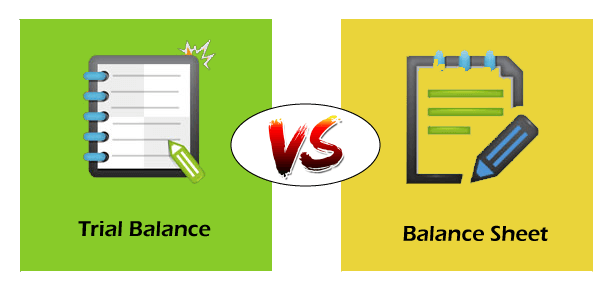Difference between Trial Balance and Balance SheetThere are several types of businesses like a sole proprietorship, partnership, corporation, private companies, public companies, etc. Every company, firm, and organization has a clear account of profits and losses that they have earned. These accounts depict the financial condition of the organization. Moreover, many journals and ledgers are also maintained wherein the names of shareholders and investors are listed. Along with that, assets and liabilities are also listed in the annual balance sheets. Now, there are two ways of showcasing the debit and credit balance. They are trial balance and balance sheet. Both of them are essential to understand the company's economic position. They are different from each another in several aspects. But, let us first discuss about the primary definition of trial balance and balance sheet. 
Trial BalanceA trial balance is defined as a ledger account that comprises of the ledger balance and the names of nominal ledger accounts. These ledgers hold the debit and credit balance of the company. The final profit and loss statement is shown in the annual balance sheet along with the other financial reports. The history of trial balances dates back to the year 1494 where it was first found in 'Summa de Arithmerica' by Luca Pacioli. The main aim of the trial balance is to show that the debit balance is equal to the credit balance. If the debit and credit balances do not match, then there is an error in the annual trial balance. A trial balance must be mathematically accurate. In this way, the company gets to know about the profits and losses they have incurred over a period of time. Now, who prepares a trial balance? Well, it is kept by an accountant or a bookkeeper who records the financial statements. These financial statements are then written into nominal ledgers and personal ledgers. There are three kinds of trial balances like the adjusted trial balance, the unadjusted trial balance, and the post-closing trial balance. Apart from the different types, there are different ways in which trial balance is prepared. They are the balance method, total-cum-balance method, and totals method. There are some cons related to trial balance as well. For instance, there are several errors that might arise during the preparation of the trial balance. Sometimes, the missing errors are not located by the accountant, which leads to several errors in the profit and loss statement. Balance SheetA balance sheet is the synopsis of the company's monetary position. The balance sheet of the company comprises of three parts, i.e., liabilities, assets, and the owner's equity. The owner' equity and liabilities are a part of financing. Assets are listed as per the liquidity order in the balance sheet. The net worth or capital is figured out by the difference of liabilities and assets. In order to calculate the total assets, liabilities have to be added with the owner's equity so that the total assets equal the finance section. Reconciliation, documentation, formal certification, etc., are some of the ways of substantiating the balance sheet. The substantiation is carried out on a monthly, quarterly, or year-end basis. Now, what is the main aim of a balance sheet? Well, a balance sheet is required to depict the financial status of the company after a specific time period. The statement shows the assets and liabilities along with the money invested in a particular business. Assets like fixed assets, tangible assets, current assets, operating assets, intangible assets, etc., are recorded in the balance sheet. Liabilities like contingent liabilities, current liabilities, and non-current liabilities are listed in the balance sheet. Now, there are certain differences between trial balance and balance sheet. So, let us have a look at them.
So, these are some of the contrasting points regarding trial balance and balance sheet. Both of them are essential for maintaining the company's financial status. The profit and losses incurred are recorded in them. Thus, both trial balance and balance sheet are significant aspects of the company/ organization.
Next TopicDifference between
|
 For Videos Join Our Youtube Channel: Join Now
For Videos Join Our Youtube Channel: Join Now
Feedback
- Send your Feedback to [email protected]
Help Others, Please Share










